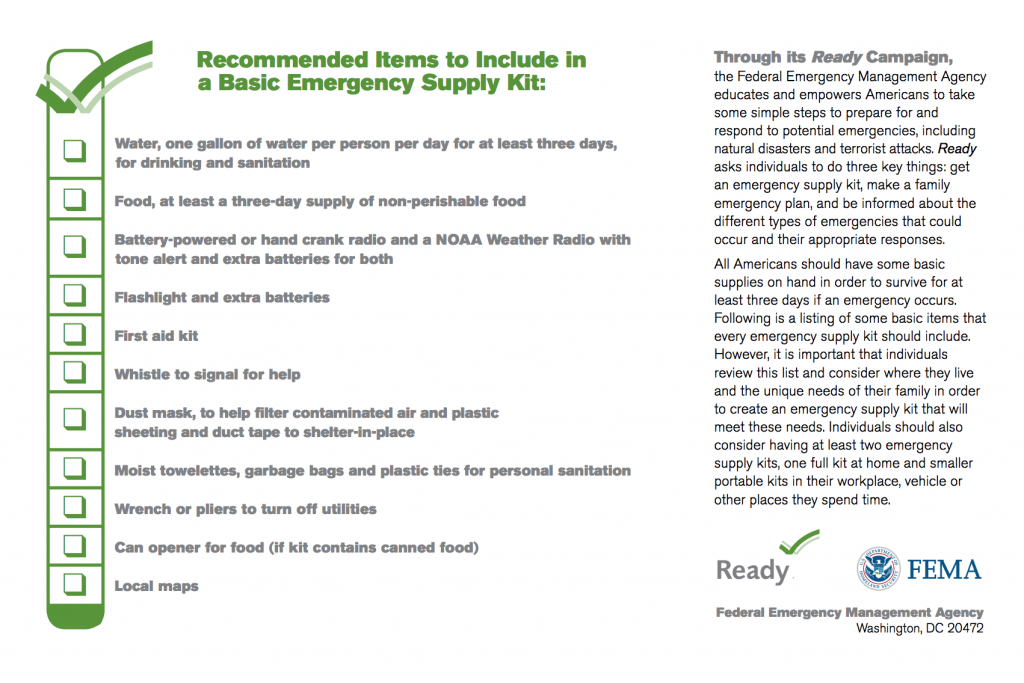Editor’s Note: This year, hurricane preparation will look a little different due to the ongoing COVID-19 pandemic. Fortunately, the Centers for Disease Control and Prevention (CDC) have recommendations on how to best stay safe before, during, and after a storm. You’ll find these guidelines added as an update to the end of this article, or you can skip directly to them here.
June 1 marked the official beginning of the Atlantic hurricane season. Though tropical storms and hurricanes are naturally occurring, these weather events can have severe economic, social, and physical impacts on society. Preparing for dangerous weather is an important part of building community resilience and promoting a speedy recovery once a storm has passed.
This month, I decided to thoroughly prepare for the upcoming storm season. There are numerous, detailed guides on how to prepare for weather emergencies, and I’ve provided the links for several of these below. Here I present to you my experiences tackling a few of these important preparations.
Review and restock emergency supplies.
 Having prepared for storms in the past, I realized I already own many important emergency supplies. To make sure I wasn’t missing anything, I revisited the emergency supply list put together by Ready.gov.
Having prepared for storms in the past, I realized I already own many important emergency supplies. To make sure I wasn’t missing anything, I revisited the emergency supply list put together by Ready.gov.
In a perfect world, I would have all of my emergency supplies in one place. In reality, they are stored in various places throughout the house. With no storm in sight, I wasn’t ready to round up all the items just yet — my can opener can stay in the kitchen, for now. But I did go around and double check that I still have items like my weather radio and flashlights, and tested to make sure they still function properly.
During my inventory I discovered some things I need to restock, including a few gallons of water and some items in my first aid kit. My nonperishable food supply is also running low. I finally used those canned green beans leftover from Hurricane Irma. After my inventory, I developed a shopping list following these food recommendations by Ready.gov. The guidelines suggest to steer clear of foods that make you thirsty (e.g. salty foods), and to make sure you choose foods you will actually eat. Peanut butter, cereal, and dried fruit are all good options for my household and will be easily obtained during my next grocery trip.
There was one item on Ready.gov’s recommended supply list that I was missing, and I honestly hadn’t even thought about it before reviewing the list: a local map. Maps make sense as an emergency supply, both for evacuation purposes and for navigating around town in the wake of downed trees and power lines. After ordering an inexpensive folding road map for the entire state of Florida online, my emergency inventory is complete.
Develop a list of important contacts.
This preparation task is recommended by the National Hurricane Center and is one I hadn’t completed in years past. Normally when I need to find contact information for an agency or business, I use Google on my smartphone or laptop. However, during a severe storm event, this may not be possible. Strong winds can take out cell towers, and power outages can limit WiFi accessibility. To prepare for that possibility, I took the time to look up contact information for the following:
- Emergency management offices
- County law enforcement
- County public safety fire/rescue
- State, county and city/town government
- Local hospitals
- Local utilities
- Local American Red Cross
- Local TV stations
- Local radio stations
- Property insurance agents
I researched the phone numbers, addresses, and websites for each of these recommended contacts in the Gainesville, Fla. area. It took me a little over an hour to complete, so I’m glad it’s something I prepared in advance of a storm. I stored some of the numbers in my phone, but I also made a comprehensive paper list to keep with my emergency supplies.
If you happen to live in Gainesville, you can print out my paper list here. If you live outside of Gainesville, you can use my list as a template to update with your own local emergency contact information.
Prepare for your pet.
 In the winter of 2018, I adopted the sweetest canine companion, and she has become a valued and beloved family member. The 2018 storm season in Gainesville was pretty quiet, and I never fully prepared for enduring a weather emergency with my dog.
In the winter of 2018, I adopted the sweetest canine companion, and she has become a valued and beloved family member. The 2018 storm season in Gainesville was pretty quiet, and I never fully prepared for enduring a weather emergency with my dog.
The Centers for Disease Control and Prevention has a thorough Pet Disaster Kit Checklist for both dogs and cats. While I fortunately already have almost everything on the list, I don’t have all the items readily accessible. I decided to gather and make copies of all the recommended documentation: veterinary records, registration information, proof of adoption, and microchip details. I made both digital copies and paper copies, which can be stored with our other storm supplies.
Following the CDC’s recommendations, I also drafted a document with recent photos of my dog, a short description, and other important information such as unique behaviors, her feeding schedule, etc. In the unlikely event that our dog goes missing or needs to be cared for by someone else, all of that information will be ready to go.
There was one item on the CDC checklist I hadn’t considered— a pet first aid book and first aid kit. Are pet first aid supplies very different than human first aid supplies? I found a great guide from the American Kennel Club (AKC) that helps answer that question. While there is some overlap in human and pet first aid supplies, there are a few additional things I still need to acquire. These include adhesive bandages made specifically for pets (apparently human adhesive bandages are NOT pet friendly), styptic to help control bleeding, and activated charcoal in case the pet ingests something poisonous.
I also needed to invest in a pet first aid book, which includes guidance on how to do pet CPR, handle choking, and deal with bleeding, trauma, and more. The AKC recommends a book by the American Red Cross, but a quick search on Amazon reveals multiple pet first aid book options. The American Veterinary Medicine Association advises that pet first aid should always be followed by immediate veterinary care. Because severe weather might delay access to that care, being prepared to administer first aid to your pet during an emergency may be truly lifesaving.
While I hope that we won’t have an active storm season this year, it feels good to know I’ve completed many important preparation tasks and I challenge you to do the same. In the event of an oncoming storm, there will still be important preparedness actions for me to take, including readying my property and assessing my risk to determine if evacuation is necessary. For more information on these and other important hurricane preparation tasks, review the links below.
Update I- Preparing for After the Storm
Since writing this post, I’ve learned that my storm preparation plans should also take into consideration what my needs might be after a storm has blown past. Thanks to Cindy Bear of the Randell Research Center for sharing the following items to stock up on in preparation for clean-up after a storm:
- A tarp or large sheet of sturdy plastic that folds easily– you might need one to seal a window or cover a roof hole.
- Work gloves in case you need to move downed vegetation or debris, such as roof shingles from your yard to get to your home. Be sure to only do this after the local power authority has certified your area clear of downed lines.
- Sun protection: reef-safe sunscreen and a hat.
- Insect protection– standing water quickly leads to population explosions of biting insects. Long sleeved shirts and long pants help reduce the need for a spray or lotion.
- Rope of several lengths and of different gauges. Rope has many uses. It can be used to string a clothesline to dry water-damaged possessions, to construct a shelter, or to create shade with the tarp you have handy!
- A 10-gallon paint bucket and kitty litter to build a portable toilet. After storms, municipal systems often lose power and water service may be out for long durations. Read how to build an emergency toilet here.
Update II- Preparing for a Storm During a Global Pandemic.
Here is the full list of recommendations produced by the CDC for hurricane preparation during a pandemic. Some important take-aways include:
- Give yourself more time to make important preparations. For those who can access it, home delivery of important supplies (emergency food, water, and medicine) is the safest option. If you must visit a store, take precautions to protect yourself and others while shopping. Gathering supplies early may help you avoid crowded stores in advance of an approaching storm.
- Make sure your emergency kit includes COVID-19 prevention supplies, including hand sanitizer or hand soap (bar or liquid), and at least two cloth face coverings per person.
- If you must evacuate, review the best practices for keeping yourself and others safe at a public shelter. Bring your emergency kit with hand sanitizer or hand soap, and at least two cloth face coverings per person.
Hurricane Preparedness Guides
National Hurricane Center Hurricane Preparedness- Be Ready: https://www.nhc.noaa.gov/prepare/ready.php
Ready.Gov- Hurricanes: https://www.ready.gov/hurricanes
Center for Disease Control and Prevention- Preparing for a Hurricane or Tropical Storm: https://www.cdc.gov/disasters/hurricanes/covid-19/prepare-for-hurricane.html
Gulf of Mexico Alliance and UF/IFAS Florida Homeowners Handbook to Prepare for Natural Hazards: http://sfyl.ifas.ufl.edu/archive/pdf/FL_homeowners_handbook.pdf
About the Author
 Sadie Mills is a coordinator and environmental educator for TESI. She manages programs and events that support TESI’s mission of educating Floridians about the state’s natural systems and the threats they face.
Sadie Mills is a coordinator and environmental educator for TESI. She manages programs and events that support TESI’s mission of educating Floridians about the state’s natural systems and the threats they face.